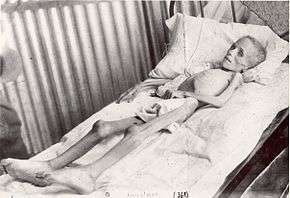Lizzie van Zyl
Lizzie van Zyl (22 April 1894 – 9 May 1901)[1][2][3][4][5][6] was a South African child inmate of the Bloemfontein concentration camp who died from typhoid fever during the Second Boer War[1][2][7].
Lizzie van Zyl | |
|---|---|
 Lizzie van Zyl | |
| Born | Elizabeth Cecilia van Zyl 22 April 1894 |
| Died | 9 May 1901 (aged 7) Bloemfontein, Orange Free State Republic |
| Cause of death | Typhoid fever |
| Burial place | Unknown but most likely in an unmarked grave in President Brand cemetery in Bloemfontein |
| Nationality | South African |
| Parents |
|
Background
Lizzie and her mother (Elizabeth Cecilia van Zyl)[6] were inmates of the Bloemfontein concentration camp. They were labelled as 'undesirables', and placed on the lowest food rations because her father, Hermanus Egbert Pieter van Zyl,[6] was still fighting the British.
Activist Emily Hobhouse used her death as an example of the hardships the Boer women and children faced in the British concentration camps during the war. She describes Lizzie as "a frail, weak little child in desperate need of good care". Initially, the publishers of Hobhouse's reports refused to publish the photograph.[7]
Lizzie died in 1901 at seven years of age.
Photo
The photo of the emaciated van Zyl reportedly was passed from British author Arthur Conan Doyle, who served as a volunteer doctor during the Boer War, to Joseph Chamberlain. Both Doyle and Chamberlain were ostensibly outspoken proponents of the Boer Wars, at least publicly; Doyle wrote a short work The War in South Africa: Its Cause and Conduct, that justified the war. The photo was used as propaganda, not as directly anti-war propaganda, but allegedly to convince the British public that Boer children were neglected by their parents.
The image was released with the detail that it was taken when van Zyl and her mother entered the camp. Chamberlain was quoted in The Times on 5 March 1902, saying that Lizzie's mother was prosecuted for mistreatment.
Emily Hobhouse investigated the case and was unable to find any evidence of a case or the prosecution of Lizzie's mother for neglect. She located the photographer, a man named Mr. de Klerk, who was also a camp inmate at the time,[7] and de Klerk stated that the photograph was taken two months after Lizzie had arrived at the camp, not when they had just arrived.
References
- "British Concentration Camps of the South African War 1900–1902: Bloemfontein". University of Cape Town. Retrieved 1 April 2012.
- van Heyningen, Elizabeth (8 June 2010). "A tool for modernisation? The Boer concentration camps of the South African War, 1900–1902" (PDF). South African Journal of Science. 106 (5–6). Retrieved 13 September 2016.
- Title: SRC 07, Type: Correspondence, Location: VAB, Reference No.: 07, Dates: May 1901, Notes: RC1918, Deaths in camps, week ending 14/5/1901
- Title: RS 30 ORC DL, Type: Death lists, Location: National Archives, Pretoria, Reference No.: RS 30, Origin: Goldman, Notes: p.353
- Title: Government Gazette of the Orange River Colony, Location: Notes:17/5/1901, p.194
- Title: SRC 71 Bloemfontein CR, Type: Camp register, Location: Free State Archives Repository, Reference No.: SRC 71, Notes: p.20
- Godby, Michael (2010). "Confronting Horror: Emily Hobhouse and the Concentration Camp Photographs of the South African War" (PDF). Department of Historical Studies. University of Cape Town. Retrieved 25 August 2016.